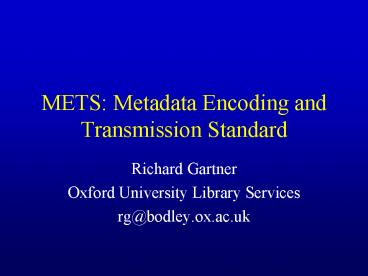METS: Metadata Encoding and Transmission Standard - PowerPoint PPT Presentation
Title:
METS: Metadata Encoding and Transmission Standard
Description:
rg_at_bodley.ox.ac.uk. The digital library: a status report ... LOCTYPE='URL' xlink:href='file://hfs.ox.ac.uk/data/odl/munahi010/digObjects/aaa ... – PowerPoint PPT presentation
Number of Views:135
Avg rating:3.0/5.0
Title: METS: Metadata Encoding and Transmission Standard
1
METS Metadata Encoding and Transmission Standard
- Richard Gartner
- Oxford University Library Services
- rg_at_bodley.ox.ac.uk
2
The digital library a status report
- Digitisation technology now well
established and well-understood - Standards for digitisation processes have
settled down and are widely recognised - Still a disparity in approaches to metadata -
no MARC standard for digital library
3
Approaches to metadata - some examples from Oxford
- Ad-hoc databases eg. Allegro
- SGML including-
- TEI alone
- TEI EAD
- Ad-hoc DTDs
- Proprietary databases eg Olive
4
The lack of a standard what it mean for the
digital library
- poor cross-searching
- limited interchange facilities
- metadata tied to proprietary packages
- consequent obsolescence and costs of conversion
5
What is needed?
- A standard for metadata content
analogous to AACR2 - A standardised framework for holding and
exchanging metadata analogous to the MARC
record
6
Three types of metadata(defined by DLF)
- Descriptive
- Administrative
- Structural
- Information about intellectual content
- (analogous to standard catalogue record)
- Information for handling, maintenance
- and archiving of object
- Description of internal structure of object
7
METS Metadata Encoding and Transmission Standard
- Produced by Library of Congress Standards Office
and Digital Library Federation - Provides framework for holding all types of
metadata for digital object - Written in XML
- Does not prescribe content of metadata, but
recommends a number of schemes for this
8
Why XML?
- An ISO standard, not dependent on any given
application - Interchangeability with other applications
- Handles structural metadata easily
- Easy to integrate cataloguing information with
text transcription, images etc.
9
Features of a METS file
- All metadata (descriptive, administrative and
structural) encoded in single document - Each type is held in a separate section, linked
by identifiers - All metadata and external data (eg. images, text,
video) is either referenced from METS file or can
be held internally
10
(No Transcript)
11
(No Transcript)
12
(No Transcript)
13
(No Transcript)
14
(No Transcript)
15
(No Transcript)
16
(No Transcript)
17
(No Transcript)
18
Descriptive and administrative metadata
- Descriptive and administrative metadata may
be handled in two ways- - embedding directly within the METS file
within an ltmdWrapgt element (with any namespace) - being held in an external file and
referenced from the METS file using an
ltmdRefgt element
19
(No Transcript)
20
(No Transcript)
21
(No Transcript)
22
(No Transcript)
23
(No Transcript)
24
What to put in a METS file?
- METS does not prescribe the content
(particularly the descriptive
metadata) which it can contain
- However, the METS board does endorse some
schemas as recommended-Descriptive
Metadata - Dublin Core
- MODS (Metadata Object Description Schema)
- MARCXML MARC 21 Schema (MARCXML) Administrative
Metadata - Schema for Technical Metadata for Text (NYU)
- Library of Congress Audio-Visual Prototyping
Project - NISO Technical Metadata for Digital Still Images
- Schema for Rights Declaration
25
METS Profiles
- METS is very flexible in its application there
are multiple ways of encoding everything- - metadata and data can be embedded or
referenced - any scheme can be used for this metadata
- file inventory can be organised in multiple ways
(by referenced object, by type of file
etc) - This all reduces interchangeability of METS
records.
26
METS Profiles
- This can be countered to some extent by METS
Profiles- - XML documents describing application of METS
in a given project/institution - follows METS Profile schema and each profile
has to validate against it - registered with central repository at Library of
Congress - But does not allow automated cross-mapping of
METS files this has to be explored
27
METS in action
- Oxford Digital Library-
- a collection of collections of material held in
Oxford libraries - METS files generated by automated webform-based
cataloguing system - descriptive metadata qualified Dublin Core
following strict cataloguing guidelines
(aimed to map to AACR2) moving to MODS being
investigated - METS files easily converted to formats of
digital library systems (currently
investigating Greenstone)
28
Conclusions
- METS will undoubtedly be the central format for
digital library metadata the MARC of the DL
worldIssues to be addressed- - standardization of metadata content and
application (an AACR2 to MET's MARC) - take-up by vendors lobbying by major bodies
- more tools needed for creation and exploitation
of METS records - critical mass
29
Further information
www.loc.gov/standards/mets www.jisc.ac.uk/index.c
fm?nametechwatch_report_0205































